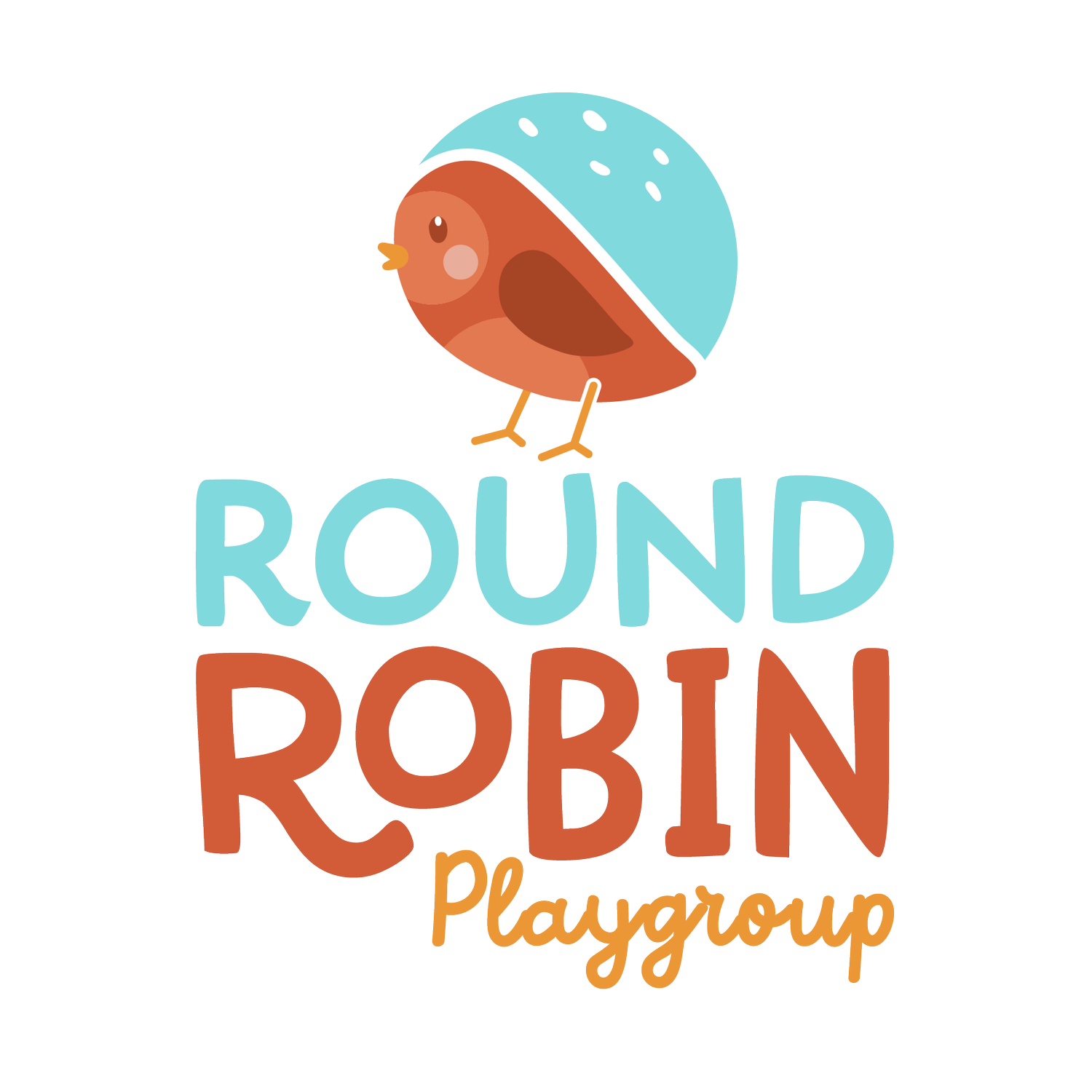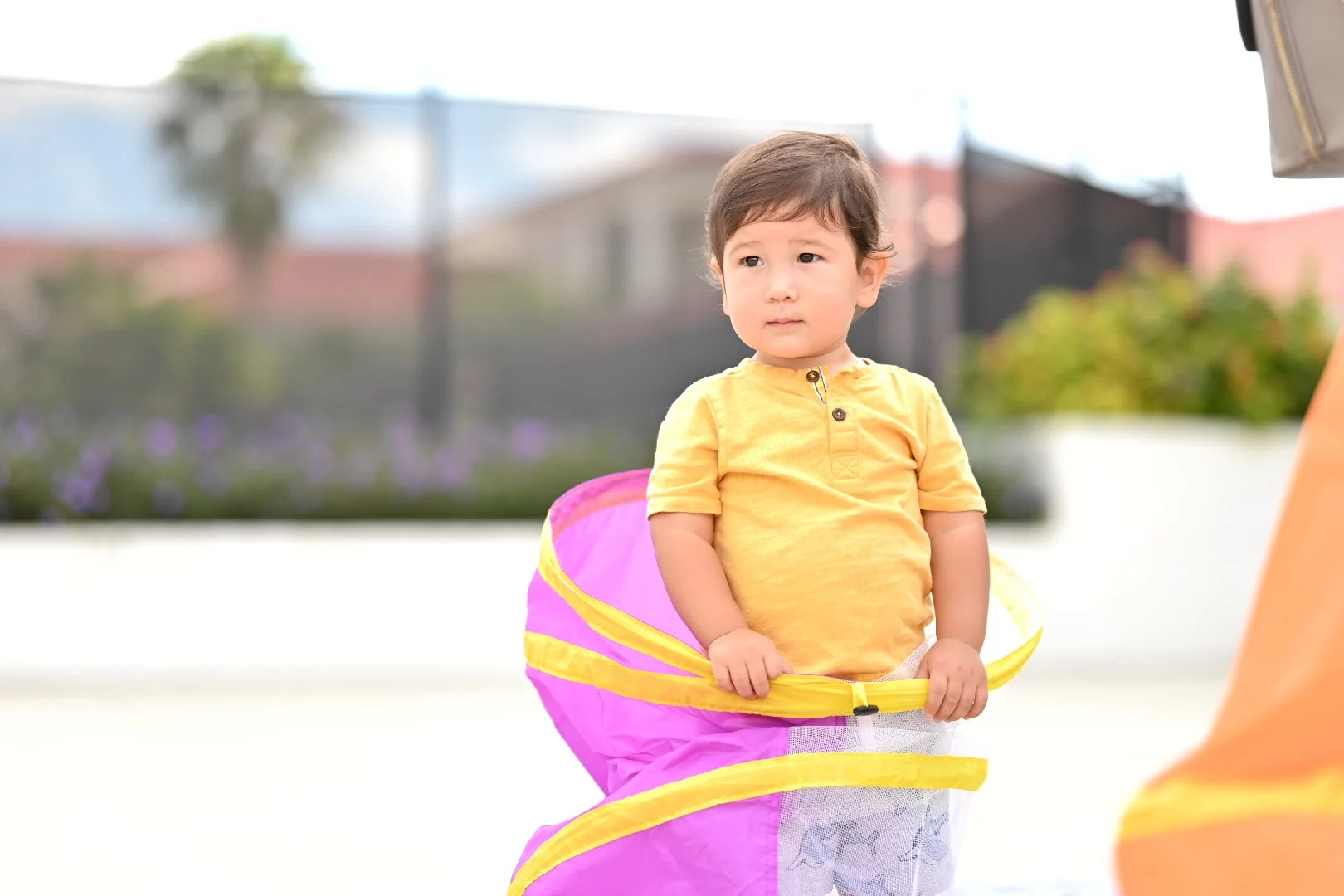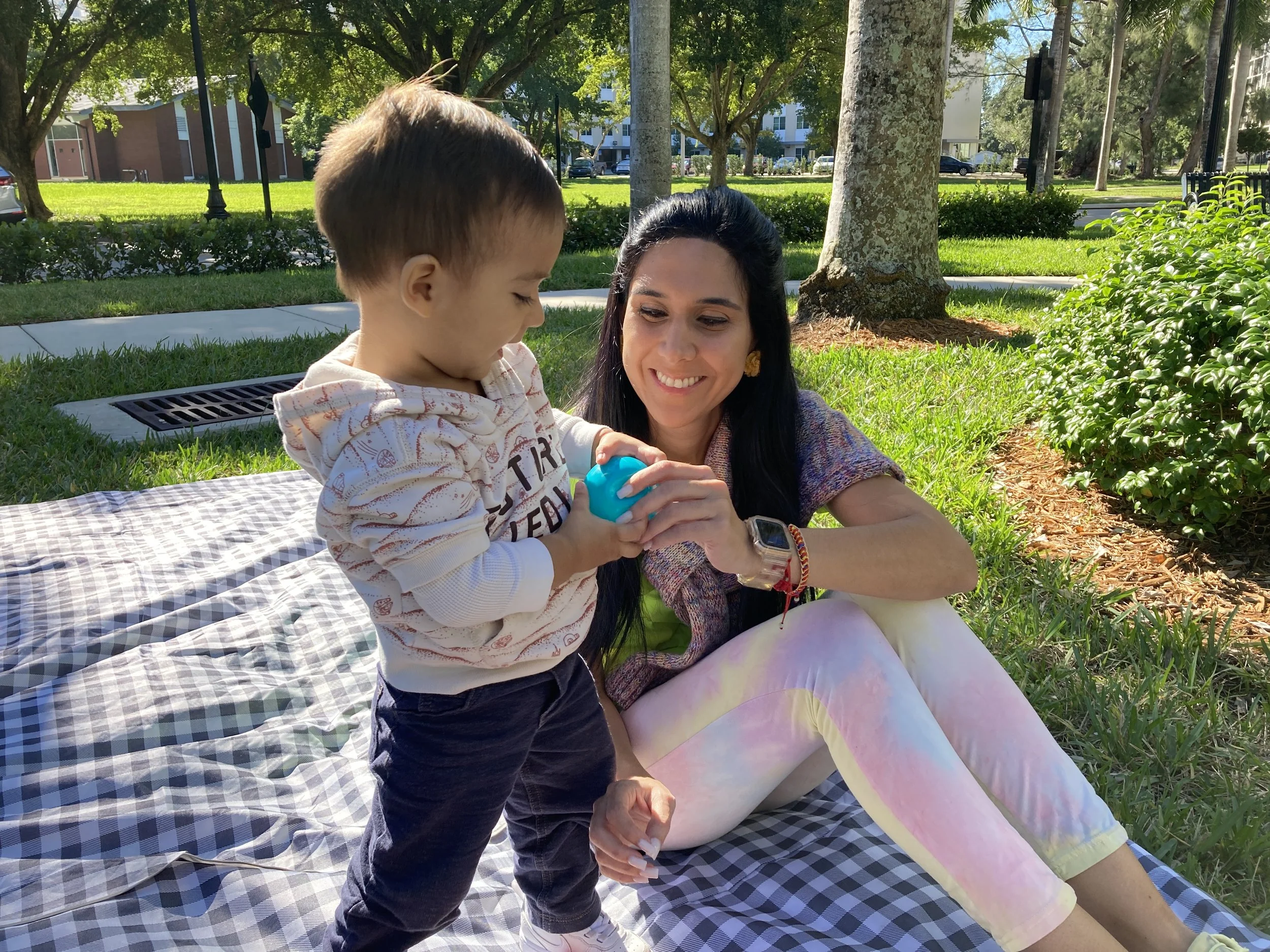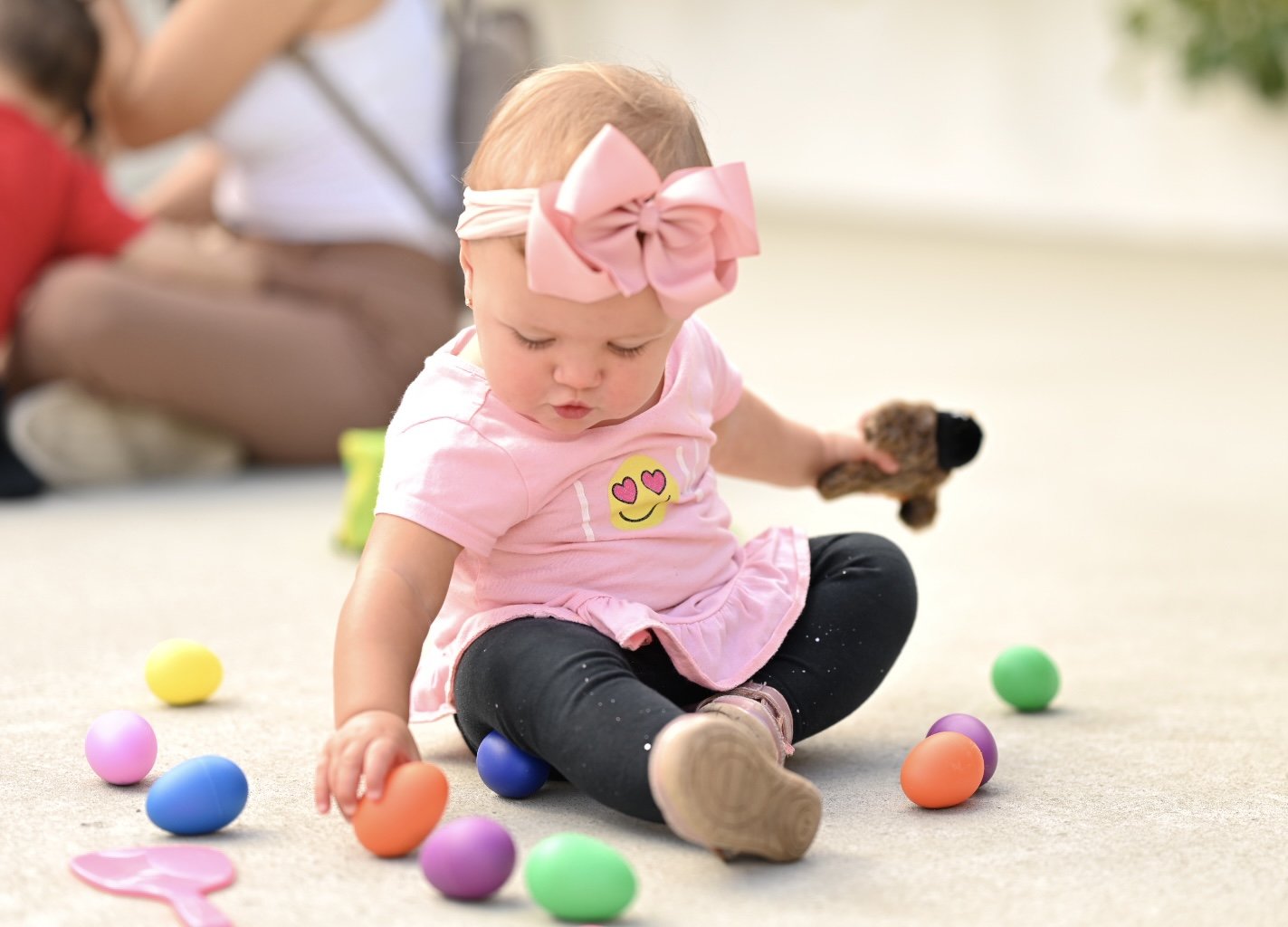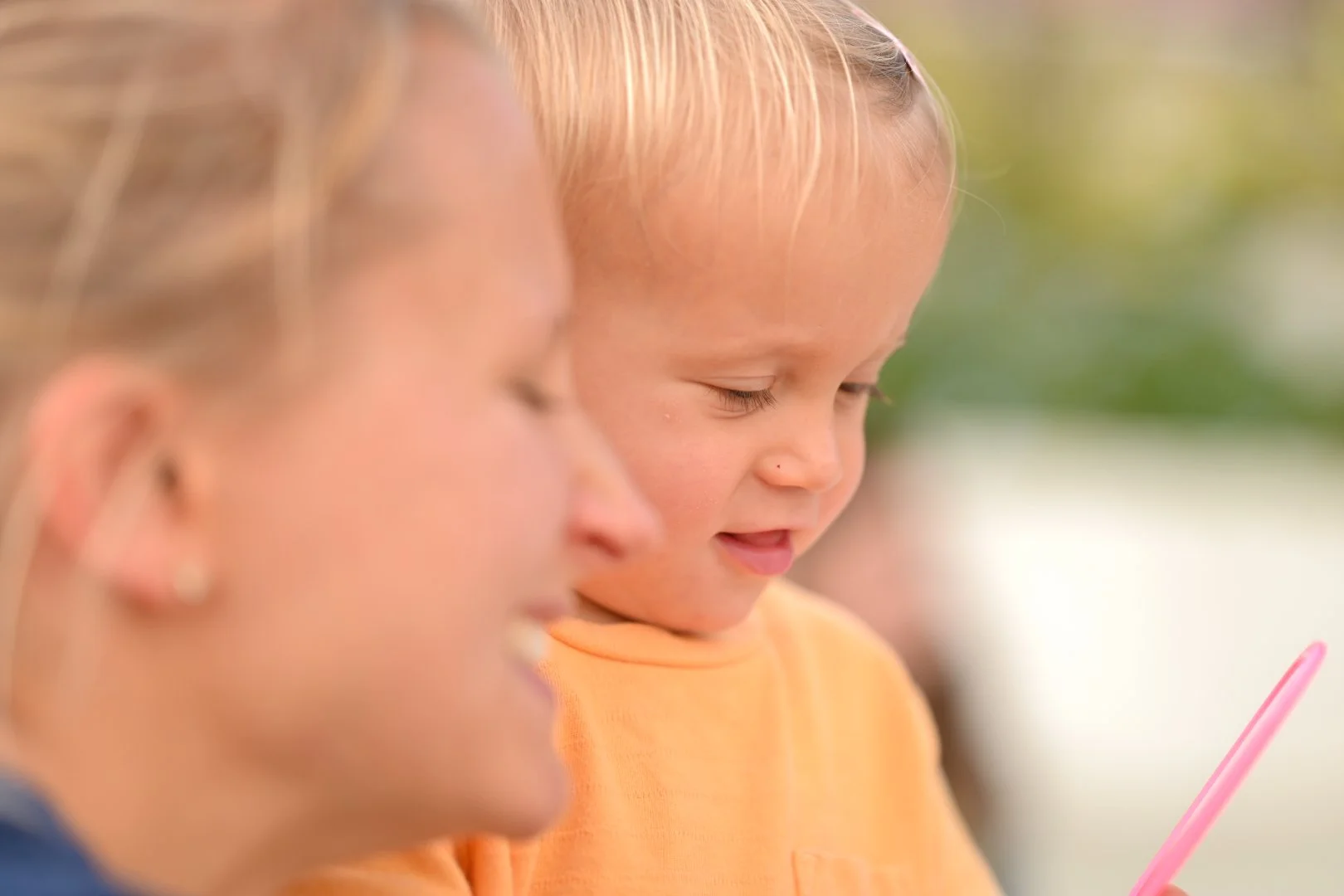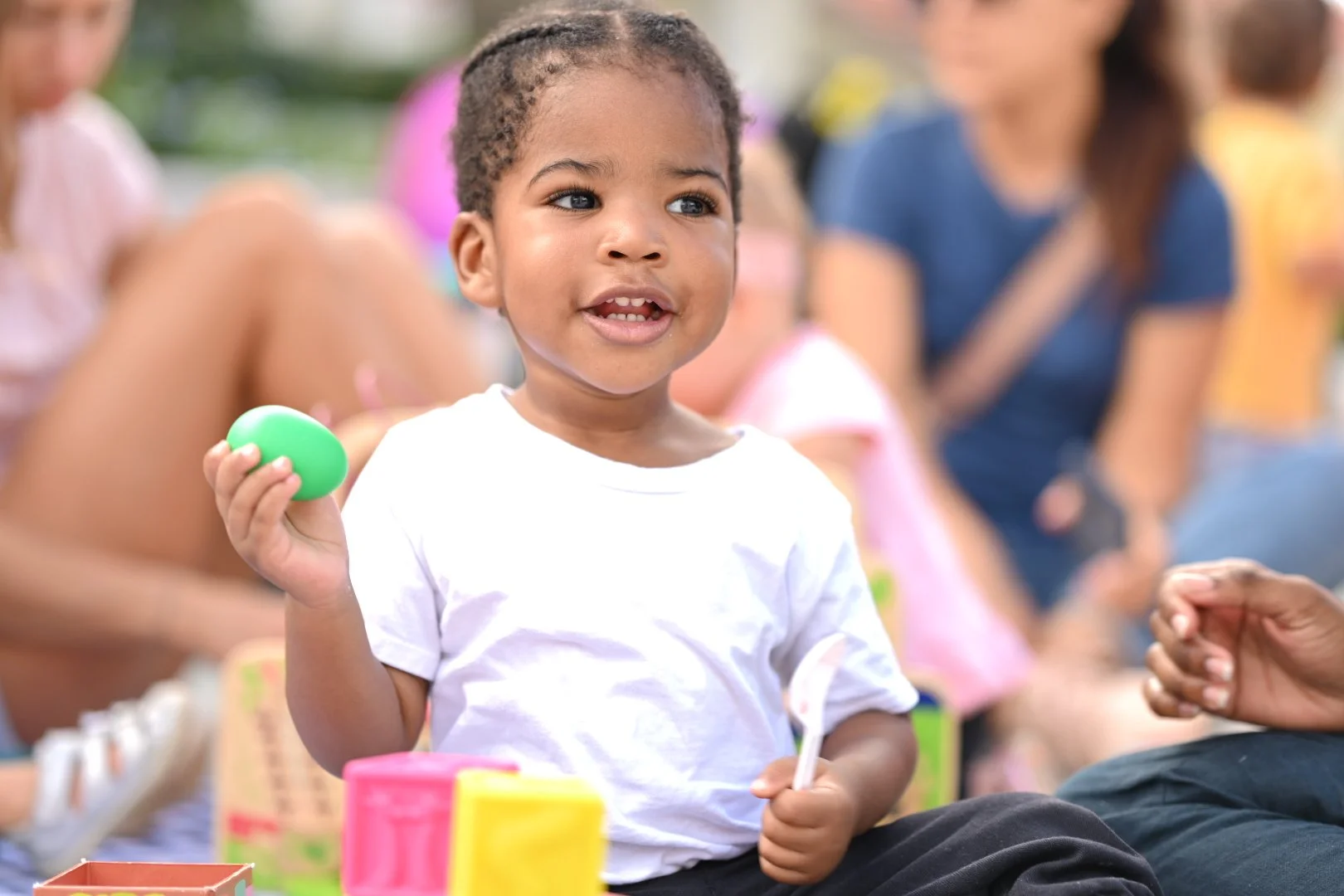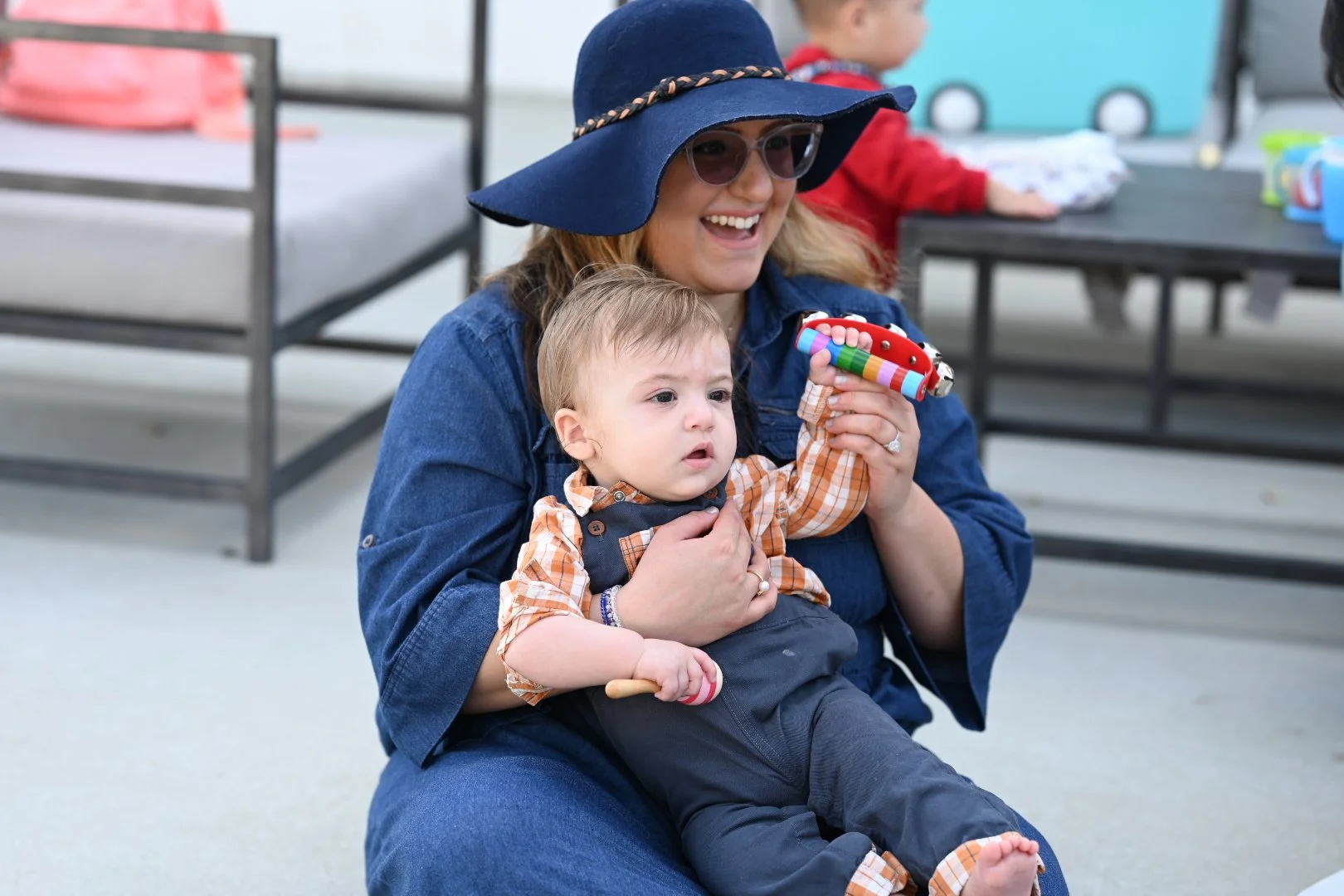
Round Robin Playgroup:
Fostering Secure Attachments through Play
by Shera Sonenberg
The type of attachment that is formed through interactions between caregiver and child is the most crucial aspect of a child’s early learning and development. The quality of the infant-caregiver relationship has a long-term impact on the child's later social and emotional outcome, including their sense of self, development, and future relationships. ‘Caregiver & Me’ programs foster secure attachment through socialization opportunities which contribute to a positive mental state for caregivers. When caregivers thrive, children thrive. Furthermore, ‘Caregiver & Me’ programs create safe environments and provide new enrichment experiences that, when combined with a secure caregiver-child attachment, boosts a child’s curiosity, creativity, and eagerness to learn, and builds emotional, social, physical, and cognitive developmental skills that are integral for future healthy growth.
Peripartum Depression
Peripartum depression – formerly called postpartum depression – has a significant impact on caregivers. But what is peripartum depression (PPD)? Unlike the “baby blues,” which refers to the short-term sadness some mothers experience after giving birth, PPD is depression that occurs both during and after pregnancy that can last for months. Symptoms include low or depressed mood, loss of interest in activities, change in appetite, sleeping difficulties (too much or too little) and loss of energy – though it can present in many other ways. PPD is a serious condition, not only because it can present as a lack of interest in the baby or lack of feeling bonded to the baby, but because depression can be debilitating for anyone.i The fact that PPD impacts new mothers who are also trying to care for a child puts an enormous strain on the caregiver-child relationship. Studies show that PPD “inhibits maternal bonding and the provision of warm and attentive care”.iii Additionally, the strain that depression can have on the caregiver-child relationship has been found to impact infant development, specifically emotional and cognitive development in later infancy. iii Research in this area has shown that children of mothers with PPD score lower on a standard cognitive score test at 18 months of age, and that this finding is especially robust in boys iv. In later infancy, PPD also affects children’s emotional development. Research into the emotional development of children of mothers with PPD has shown high rates of insecurity and anxiety, compared to a control group of children whose mothers did not have PPDv. Research also finds a direct correlation between paternal postpartum depression with maternal postpartum depression, which has important implications for family health and well-being vi.
Social Support Networks
While it is unclear what causes peripartum depression, studies have shown an increased risk of peripartum depression in those who lack social support.vii One study in California that used the data from the Listening to Mothers in California Survey, found that social support groups “serve[d] as a robust protective factor against postpartum symptoms” of peripartum depression.viii Another study, which looked at both teen and adult mothers, found that while teens were slightly more likely to develop peripartum depression, both groups were more likely to experience it if they received little or no support after birth, leading the authors to conclude that social support was crucial for mothers of all ages to prevent peripartum depression.ix ‘Caregiver & Me’ programs create a network of support for caregivers that can alleviate or protect against peripartum depression.
The importance of a support network for caregiver’s post-birth cannot be overstated, and the benefits impact both the caregiver and the child. But how do we define support network? First, we should understand the concept of social support, which has been defined by researchers as “support which is considered functional, and which leads the receiver of the support to feel cared for, valued and with a sense of belonging to a larger network.”x Functional support has been further broken down into five categories: emotional, informational, instrumental, comparison or appraisal, and social companionship, and the presence of any of these types of support can be critical in alleviating caregiver stress.xi So, the most effective types of support for new parents/caregivers should have some element of social support, and should be functional in one way or another.
‘Caregiver & Me’ programs, by their design, offer socialization opportunities for caregivers by bringing them into contact with other caregivers. Just getting out of the house can be a challenge for new parents, and early parenthood can be isolating.xii Though many ’Caregiver & Me’ programs are marketed as primarily for children, the opportunity for new parents to meet other new parents and form friendships – and, additionally, find people who are going through what they are going through – is a prime example of functional support. By bringing caregivers into contact with each other, these programs also enable caregivers to share information with each other. Additionally, the groups themselves can offer knowledge and awareness of local and national resources.
Secure Attachments
While the research suggests that social support is beneficial to caregivers, the substantial benefits to children cannot be overlooked. When caregivers and children play and interact together, the benefits to children can be enormous. When parents observe their children in play or join with them in child-driven play, they are given a unique opportunity to see the world from their child’s perspective. The interactions that occur during play form secure attachments, which contributes to healthier child development in many different ways.xiii, xiv
Developing a secure attachment to their caregivers is critical to childhood and even adult development. According to the Berkely-based developmental psychologist Diana Divecha, secure attachment has at least three functions: “Provides a sense of safety and security; regulates emotions by soothing distress, creating joy and supporting calm; and offers a secure base from which to explore.” xv There are four types of infant-parent attachment- three “organized” types and one “disorganized” type.xvi The three organized types include secure, avoidant, and resistant. xvii Attachment strategies in the infant develop at about six months of age and are responses that the child learns to use in response to their caregiver’s behavior. xviii Secure attachment develops when the child learns to trust that their caregiver will respond in a loving and consistent manner to meet their needs; avoidant attachment styles are developed when children learn that their caregiver may be insensitive and rejecting of their needs; and resistant attachment develops when a child learns that their caregiver is insensitive and inconsistent in meeting their needs. xix The last form of attachment, the disorganized form, is developed when a child receives atypical attention from their caregivers, such as being sexually or physically abused, or being severely emotionally or physically neglected. xx
Attachment styles are not only important in childhood, however. Of the four patterns of attachment, the disorganized style is most likely to lead to serious psychopathology and maladjustment in childhood and adulthood. xxi However, the organized patterns of avoidant and resistant also have effects into later childhood and adulthood and have been shown to be a risk factor for later development. xxii
Of the four types of attachment, secure attachment styles are the most beneficial for later relational development in the child and is a protective factor against emotional and social maladjustment. xxiii The value of developing a secure attachment style cannot be overstated. As Divehca writes, “One of the most important (and paradoxical) findings was that a secure attachment early in life led to greater independence later, whereas an insecure attachment led children to be more dependent later in life.” xxiv Secure attachment leads children to develop a greater sense of agency, as well as better emotional regulation and higher self-esteem. xxv Having a secure attachment in childhood can help children develop leadership skills and helps them build healthy adult relationships. Developing a secure attachment is fundamental for helping infants develop into healthy children and adults but having a secure attachment style is not the only benefit to children. The next section discusses the additional developmental benefits to children of having secure attachments to their caregivers.
Secure Attachments: The Additional Developmental Benefits to Children
Healthy Brain Development
The concept of ‘serve and return‘ refers to a child’s interactions with caregivers. When a young child babbles, gestures or cries, and their caregiver responds with appropriate eye contact, words or a hug, neural connections are made in the infant’s brain.xxvi These connections help develop communication and social skills. In this way, the child’s social environment is like a volleyball game: they send out a message using verbal or body language, and they receive reinforcing feedback from their caregiver. A Harvard university scholar writes about serve and return in this way; “Early experiences affect the development of brain architecture, which provides the foundation for all future learning, behavior, and health. Just as a weak foundation compromises the quality and strength of a house, adverse experiences early in life can impair brain architecture, with negative effects lasting into adulthood.”xxvii
‘Caregiver & Me’ programs introduce infants and toddlers to new experiences, thus providing opportunities to create new ‘brain files.’ This boosts curiosity, creativity, and eagerness to learn new skills xxviii What are brain files? Brain files is a term coined by Australian early childhood educators and it refers to the demonstration in a high level of interest and vocabulary for a particular subject, such as flowers or dinosaurs. The development of brain files provides an excellent basis on which to develop further learning and understanding. xxix
‘Caregiver & Me’ Programs Aid Cognitive, Social, Emotional, & Physical, Development
‘Caregiver & Me’ programs can help children learn about the world around them through play, express their feelings, identify others' emotions, practice problem-solving, improve motor skills, and much more. Play is crucial to the healthy cognitive, social, emotional, and physical development of infants and children.xxx These benefits of play to children are described in further detail below.
1. Cognitive development: Play builds executive function skills and creative thinking. For example, when they play with bricks or draw, they learn counting, classifying and pattern-making skills. They also learn how to practice storytelling, enhance their vocabulary, and writing skills when they engage in creative activities such as dramatic play. Engaging in construction play such as playing with blocks and other building toys has been particularly shown to build problem solving and mathematical skills. xxxi In short, play helps children develop the power to solve problems xxxii.
2. Social development: When children play together, they build social skills and learn how to notice social cues such as listening and taking another’s perspective. These are all key aspects to developing empathy. Social play also requires children to learn negotiating and compromising skills as well as learning how to express and share their own ideas and opinions of how play should progress. xxxiii
3. Emotional development: Children learn self-regulation when follow social norms in social and guided play. They learn how to pay attention to their inner cues when they experience feelings such anticipation and frustration. When they have these feelings, when they are guided by adults, they can learn how to express these feelings in a healthy and productive way. They also learn leadership and teamwork skills; play teaches them when they should lead, and when they should follow. They learn how to communicate their needs to others, and to listen and understand other’s needs. Play allows children to test out emotional concepts and ideas such as love, friendship, wisdom and safety. Play can even safely trigger the ‘flight or fight’ response, which allows children to test out their response to danger in a controlled environment. Lastly, play teaches children how to set and change rules in a dynamic and natural way. xxxiv
4. Physical development
Children learn to play through their bodies, and physical development leads to success in other domains. Physical activities build gross and fine motor skills. While sport immediately comes to mind, other forms of physical activity such as outdoor games and dance, children develop strength, muscle control, coordination, and the development of physical reflexes. Physical games and sports teach children to push their limits and try new things. xxxv
Enrichment classes like those offered at ‘Caregiver & Me’ teach and reinforce a child’s idea of appropriate independence and boundaries. They learn through their experiences by observing adults and other children. Children learn through watching: they observe other children’s behaviors, and they can learn what behaviors garner positive reinforcement from adults and what behaviors receive negative reinforcement. Play allows them a safe space to help them start developing independent identities, and these opportunities for play provide an outlet for personal exploration. Play allows them to learn life skills such as problem solving, taking turns, sharing and negotiating, and learning about rules about what is fair and unfair. xxxvi
Round Robin Playgroup’s Impact
Given the vital benefits that ‘Caregiver & Me’ programs provide, they should be financially accessible to every Caregiver and Child. However, this is not the case in Miami. 21.1 percent of Miami's children live below the poverty line. Specifically, 63% of all Miami-Dade children ages 0-2 live in families below ALICE (Asset Limited, Income Constrained, Employed) or below the federal poverty line (See Table 1). Miami's 'Caregiver & Me' programs are priced as luxury services. An hour-long session can cost up to $60 (See Table 2). This means thousands of low-medium income families forgo crucial, facilitated bonding experiences, negatively impacting both the child’s and Caregiver’s wellbeing.
Round Robin Playgroup's mission is to provide opportunities and resources that create equitable access to high-quality 'Caregiver & Me' Playgroups to support early childhood development and encourage secure relationships. Our 'Pay What You Can' donation-based model reduces financial barriers and enables our organization to redistribute funding to establish Playgroups in underserved communities throughout Miami-Dade. It allows all families to participate in and benefit from our Playgroup Model regardless of socioeconomic status.
Our unique program model provides all of our Playgroups with the opportunities and professionally crafted resources needed to run successful Playgroups. Our curriculum ROBIN’S WINGS© (Warm Interactions Nurturing Growth & Skills) strengthens secure attachments and warm relationships through bonding activities and educational resources enhancing caregivers' awareness about developmentally appropriate expectations.
Round Robin Playgroup creates a network of families dedicated to building meaningful bonds and enhancing our children's early years. Our model levels the ‘playing-field’ creating opportunities for all caregivers and children to build secure attachments and reap the numerous benefits that a social support network and enrichment activities can provide.
Recent Data Reflecting Costs of ‘Caregiver & Me’ programs vs. Socio-Economic Status of Children Ages 0-2 in Miami-Dade County
Note: Adapted from ALICE Threshold, 2019; US Census Bureau, American Community Survey, PUMS, 2019; Consists of Miami-Data County Public Use Microdata Areas (PUMAs). Values represent counts (No.) and percent (%) of total children 0-2 years of age falling below ALICE and poverty line.
Endnotes
(“Psychiatry.Org - What Is Peripartum Depression (Formerly Postpartum)?” n.d.) ii (“The Impact of Postpartum Depression on the Mother-Child Relationship” n.d.) iii (Feinberg et al. 2022) iv (“The Impact of Postnatal Depression and Associated Adversity on Early Mother-Infant Interactions and Later Infant Outcome” 2023) v (Teti et al. 1995) vi (Goodman 2004) vii (Ardiani, Soemanto, and Murti 2020) viii (Feinberg et al. 2022) ix (Kim, Connolly, and Tamim 2014) x (De Sousa Machado, Chur-Hansen, and Due 2020a) xi (De Sousa Machado, Chur-Hansen, and Due 2020b) xiixii (“5 Ways Mommy and Me Classes Benefit You and Your Child | Sawyer Blog” n.d.) xiii (Faisal-Cury et al. 2021) xiv (Murray and Cooper 1997) xv (“Why Attachment Parenting Is Not the Same as Secure Attachment” n.d.) xvi (Benoit 2004) xvii (Benoit 2004) xviii (Benoit 2004) xix (Benoit 2004) xx (Benoit 2004) xxi (Boris, Fueyo, and Zeanah 1997) xxii (Benoit 2004) xxiii (Egeland and Hiester 1995) xxiv (“Why Attachment Parenting Is Not the Same as Secure Attachment” n.d.) xxvxxv (“Why Attachment Parenting Is Not the Same as Secure Attachment” n.d.) xxvi (“Serve and Return” n.d.) xxvii (“Serve and Return” n.d.) xxviii (van Aswegen and Pendergast 2010) xxix (van Aswegen and Pendergast 2010) xxx (Rauf and Bakar 2019) xxxi (“Summertime, Playtime” n.d.) xxxii (“Defining the Skills for Success” n.d.) xxxiii (“Summertime, Playtime” n.d.) xxxiv (“Summertime, Playtime” n.d.) xxxv (“Summertime, Playtime” n.d.) xxxvi (Judge 2019) xxxvi (Rauf and Bakar 2019)
References:
“5 Ways Mommy and Me Classes Benefit You and Your Child | Sawyer Blog.” n.d. Accessed January 2, 2023. https://www.hisawyer.com/blog/5-ways-mommy-and-me-classes-benefit-you-and-your-child.
Ardiani, Ardiani, Rb Soemanto, and Bhisma Murti. 2020. “Meta-Analysis: The Association between Social Support and Postpartum Depression.” Journal of Maternal and Child Health 5 (6): 641–50. http://thejmch.com/index.php?journal=thejmch&page=article&op=view&path%5B%5D=504.
Aswegen, Christa van, and Donna Pendergast. 2010. “Evaluating an Enrichment Program in Early Childhood: A Multi-Methods Approach.”
Benoit, Diane. 2004. “Infant-Parent Attachment: Definition, Types, Antecedents, Measurement and Outcome.” Paediatrics & Child Health 9 (8): 541–45. https://doi.org/10.1093/pch/9.8.541.
Boris, NEIL W., MICHAEL Fueyo, and CHARLES H. Zeanah. 1997. “The Clinical Assessment of Attachment in Children Under Five.” Journal of the American Academy of Child & Adolescent Psychiatry 36 (2): 291–93. https://doi.org/10.1097/00004583-199702000-00020.
De Sousa Machado, Tiffany, Anna Chur-Hansen, and Clemence Due. 2020a. “First-Time Mothers’ Perceptions of Social Support: Recommendations for Best Practice.” Health Psychology Open 7 (1): 2055102919898611. https://doi.org/10.1177/2055102919898611. ———. 2020b. “First-Time Mothers’ Perceptions of Social Support: Recommendations for Best Practice.” Health Psychology Open 7 (1): 2055102919898611. https://doi.org/10.1177/2055102919898611.
“Defining the Skills for Success.” n.d. Harvard Graduate School of Education. Accessed January 3, 2023. https://www.gse.harvard.edu/news/uk/16/12/defining-skills-success.
Egeland, Byron, and Marnie Hiester. 1995. “The Long-Term Consequences of Infant Day-Care and Mother-Infant Attachment.” Child Development 66 (2): 474–85. https://doi.org/10.2307/1131591.
Faisal-Cury, Alexandre, Karen M. Tabb, Carolina Ziebold, and Alicia Matijasevich. 2021. “The Impact of Postpartum Depression and Bonding Impairment on Child Development at 12 to 15 Months after Delivery.” Journal of Affective Disorders Reports 4 (April): 100125. https://doi.org/10.1016/j.jadr.2021.100125.
Feinberg, Emily, Eugene Declercq, Annette Lee, and Candice Belanoff. 2022. “The Relationship between Social Support and Postnatal Anxiety and Depression: Results from the Listening to Mothers in California Survey.” Women’s Health Issues 32 (3): 251–60. https://doi.org/10.1016/j.whi.2022.01.005.
Goodman, Janice H. 2004. “Paternal Postpartum Depression, Its Relationship to Maternal Postpartum Depression, and Implications for Family Health.” Journal of Advanced Nursing 45 (1): 26–35. https://doi.org/10.1046/j.1365-2648.2003.02857.x.
Judge, Tessa. 2019. “4 Reasons Preschoolers Need Enrichment Classes.” Indy’s Child Magazine. September 26, 2019. https://indyschild.com/4-reasons-preschoolers-need-enrichment-classes/.
Kim, Theresa HM, Jennifer A. Connolly, and Hala Tamim. 2014. “The Effect of Social Support around Pregnancy on Postpartum Depression among Canadian Teen Mothers and Adult Mothers in the Maternity Experiences Survey.” BMC Pregnancy and Childbirth 14 (1): 162. https://doi.org/10.1186/1471-2393-14-162.
Murray, Lynne, and Peter J. Cooper. 1997. “EDITORIAL: Postpartum Depression and Child Development.” Psychological Medicine 27 (2): 253–60. https://doi.org/10.1017/S0033291796004564.
“Psychiatry.Org - What Is Peripartum Depression (Formerly Postpartum)?” n.d. Accessed January 1, 2023. https://www.psychiatry.org:443/patients-families/peripartum-depression/what-is-peripartum-depression.
Rauf, Aqila Liyana Abdul, and Kamariah Abu Bakar. 2019. “Effects of Play on the Social Development of Preschool Children.” Creative Education 10 (12): 2640–48. https://doi.org/10.4236/ce.2019.1012191.
“Serve and Return.” n.d. Center on the Developing Child at Harvard University. Accessed January 2, 2023. https://developingchild.harvard.edu/science/key-concepts/serve-and-return/.
“Summertime, Playtime.” n.d. Harvard Graduate School of Education. Accessed January 2, 2023. https://www.gse.harvard.edu/news/uk/18/06/summertime-playtime.
Teti, Douglas M., Donna M. Gelfand, Daniel S. Messinger, and Russell Isabella. 1995. “Maternal Depression and the Quality of Early Attachment: An Examination of Infants, Preschoolers, and Their Mothers.” Developmental Psychology 31 (3): 364–76. https://doi.org/10.1037/0012-1649.31.3.364.
“The Impact of Postnatal Depression and Associated Adversity on Early Mother-Infant Interactions and Later Infant Outcome.” 2023.
“The Impact of Postpartum Depression on the Mother-Child Relationship.” n.d. Accessed January 1, 2023. https://wp.nyu.edu/steinhardt-appsych_opus/the-impact-of-postpartum-depression-on-the-mother-child-relationship/.
“Why Attachment Parenting Is Not the Same as Secure Attachment.” n.d. Greater Good. Accessed January 10, 2023. https://greatergood.berkeley.edu/article/item/why_attachment_parenting_is_not_the_same_as_secure_attachment.
